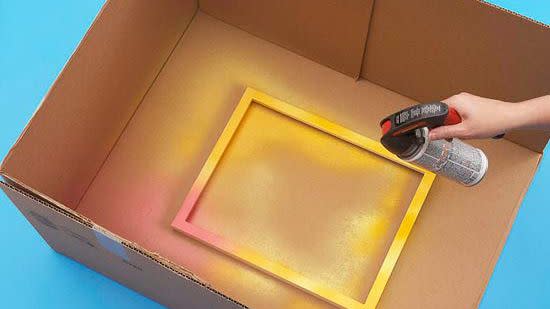How to Use Spray Paint on Furnishings, Decorative Objects, and More

There's a certain satisfaction in hearing the jingle of a spray-paint can and watching a stream of color transform a surface. Use these techniques to give a new attitude to just about anything.
How to Use Spray Paint Basics

Choose your location. A well-ventilated place will protect you from paint fumes. Outdoors is best, but an open garage is a good second choice. If you have to be indoors, open as many windows as possible and use a fan while spraying and drying.
Protect from overspray. Set small projects in a deep cardboard box, or put down a drop cloth when working with bigger pieces.
Prepare the surface. Most materials must be cleaned, sanded, and dried for best results before spray-paint application. Applying a primer will result in a smoother surface, truer color, and longer-lasting finish.
Read all directions. Check the can for how to use spray paint, the proper distance for spraying, and the drying times needed before you begin painting.
Test your spray paint. Try a practice spray on a piece of scrap material with the same surface as your project. A steady spray tool offers an easy-to-use trigger that creates an even stream of paint.
Apply multiple thin coats. Sweep the paint can so you spray across the project, beginning and ending each coat off the side. Complete a coat over the entire project all at once, instead of working in stages. This will give you a more consistent color and finish. Consult the canister for the recommended time to apply several coats before allowing time for the paint to cure, known as the "recoat window."
Allow the project to dry. Different brands and finishes require specific drying times. Wait the recommended time before moving the project from the work area.
Clean spray valve. Prevent clogging by holding the can upside down and spraying until only clear gas is released. If a tip does become clogged, wipe off the opening with warm water or lacquer thinner. Never stick a pin or wire into the hole.
How to Prepare a Surface for Spray Paint
Ceramic: Rough up a glazed surface with sandpaper. Some kiln-set paints are available at crafts stores.
Fabric and vinyl: Prewash apparel-grade fabrics before spray painting. Check to ensure upholstery and outdoor fabrics are not treated with protectants that might prevent paint adhesion. Airbrush-like applicators work best for detailed designs (try Testors brand). Rust-Oleum makes a special vinyl spray designed for bringing back shine.
Glass: Create custom-etched looks with stencils and frosted glass paint (we like Krylon Frosted Glass), or add privacy with pearlized, translucent sprays.
Metal: If you're repainting a rusted appliance or grill, use specialty paint with magnetic or heat-resistant qualities. Remove existing rust and oil and lightly sand glossy surfaces before you begin.
Plastic: Clean new plastics with a paint thinner and older plastics with an ammonia-based cleaner. Krylon's Fusion line is designed to bond to plastic, PVC, and resin.
Sisal: Shake out or vacuum the rug to remove loose fibers before you tape down a pattern or stencil. Then, spray a coat of polyurethane sealer over your colorful paint to keep your design looking crisp.
Wicker: Lightly sand, wipe clean, and prime wooden wicker before spraying with an indoor/ outdoor product. The surface should be dry and look dull before spraying. For resin wicker, clean with an ammonia-base cleaner. New plastic pieces also should be wiped down with paint thinner. When dry, apply a spray paint designed for plastics.
Wood: Remove previous paint and/or stain. Sand and wipe clean before applying a fresh coat.
